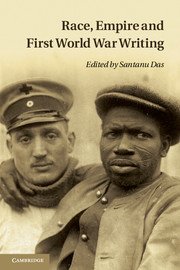Book contents
- Frontmatter
- Contents
- List of illustrations
- Acknowledgements
- Notes on contributors
- Introduction
- PART I VOICES AND EXPERIENCES
- PART II PERCEPTIONS AND PROXIMITIES
- 6 Representing Otherness: African, Indian and European soldiers' letters and memoirs
- 7 Living apart together: Belgian civilians and non-white troops and workers in wartime Flanders
- 8 Nursing the Other: the representation of colonial troops in French and British First World War nursing memoirs
- 9 Imperial captivities: colonial prisoners of war in Germany and the Ottoman empire, 1914–1918
- 10 Images of Te Hokowhitu A Tu in the First World War
- PART III NATIONALISM, MEMORY AND LITERATURE
- Index
- References
9 - Imperial captivities: colonial prisoners of war in Germany and the Ottoman empire, 1914–1918
Published online by Cambridge University Press: 05 February 2014
- Frontmatter
- Contents
- List of illustrations
- Acknowledgements
- Notes on contributors
- Introduction
- PART I VOICES AND EXPERIENCES
- PART II PERCEPTIONS AND PROXIMITIES
- 6 Representing Otherness: African, Indian and European soldiers' letters and memoirs
- 7 Living apart together: Belgian civilians and non-white troops and workers in wartime Flanders
- 8 Nursing the Other: the representation of colonial troops in French and British First World War nursing memoirs
- 9 Imperial captivities: colonial prisoners of war in Germany and the Ottoman empire, 1914–1918
- 10 Images of Te Hokowhitu A Tu in the First World War
- PART III NATIONALISM, MEMORY AND LITERATURE
- Index
- References
Summary
The First World War resulted in radically new encounters between colonial subjects and the imperial sphere which have only recently become the focus of historical research. Yet one key aspect of this wartime interaction has remained overlooked: how First World War captivity led to new exchanges between African and Asian colonial troops and Europeans. This chapter explores captivity as a site of cultural interaction between African and Asian colonial subjects and white Europeans by juxtaposing two imperial case studies, Wilhelmine Germany and Ottoman Turkey, to see how captivity influenced ideas of ‘race’ and identity and disrupted existing power hierarchies.
An enormous range of diverse imperial–colonial encounters (that is, interactions between colonial subjects and the imperial sphere) occurred in these two environments. In Germany, this chapter will explore how African and Asian colonial prisoners, captured on the Western Front, encountered German captors, German civilians, and representatives of Germany's Turkish ally, who visited their prison camps, as well as numerous prisoners of war from different ethnicities and nationalities, both non-European and European. In Ottoman-controlled Mesopotamia, this study will show how British and Indian soldiers shared a common captivity during the initial phase of capture following the fall of Kut-el-Amara in 1916, which led them to view each other in new ways as they responded to Turkish captors, as well as Arab and Kurdish guards, and the myriad different civilian ethnic groups of the Ottoman Empire.
- Type
- Chapter
- Information
- Race, Empire and First World War Writing , pp. 175 - 193Publisher: Cambridge University PressPrint publication year: 2011
References
- 8
- Cited by

